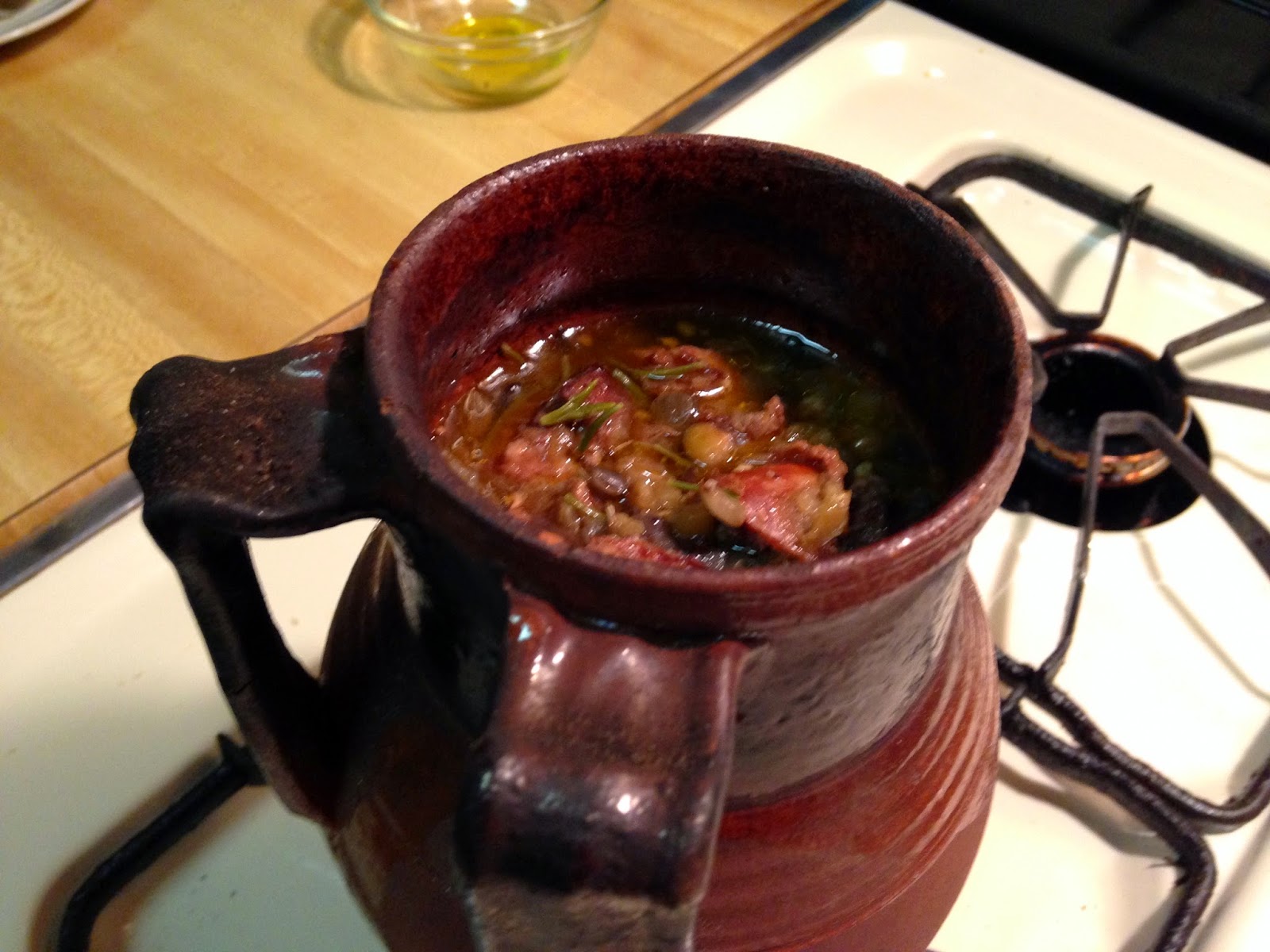"Good
cooking is contemplative, it’s subtle. It’s timeless. It’s humbling to think of
humanity, hunched over a fire, the clay pot one of our very few constants in a
long and winding history." - Silvestro Silvestori
 |
| Cooking with a pignata in our clay oven |
Here are some basic recipes for cooking in a pignata. I will be adding more recipes
regularly.
- Cannellini Beans with Pancetta
Ingredients:
2 cups dry Cannellini beans (or 2 cans of canned )
1/4 lb pancetta roughly chopped
1/2 medium yellow onion chopped
1 bay leaf torn in three pieces
1/2 teaspoon black peppercorns
1 teaspoon fresh rosemary
1/2 teaspoon fennel seeds
Extra Virgin Olive Oil
Salt
Water
If using dry beans, they need to be pre-soaked before using.
Technique:
- Sort through the beans and eliminate shriveled beans and any debris.
- Soak for 12 hours or over night covering the beans with about 2 inches of
water.
- Drain and put into a cooking pot again covered with about 2 inches of
water.
- Bring the water to a boil. Boil for 5 minutes then remove from heat and
let sit for an hour.
- Now they’re ready to put in the pignata.
I decided to fry the pancetta to render some of the fat and crisp it up a little. Then saute the onion in the fat. Cut the pancetta into several pieces.
Put all the ingredients except the salt into the pignata and add water to the top of the beans. Salt should be added when the beans are done.


Place the pignata with the beans in the oven near the embers. We cooked them along with pan roasted chicken thighs in our clay oven. About an hour and a half. The beans can cook even longer. The longer they cook the better they get.
- Lentils with Italian sausage
Ingredients:
1 cup of dry lentils
1/2 cup sweet onion chopped
3 cloves of garlic minced
2 Hot Italian sausage links
2 sprigs fresh rosemary
Soak the lentils in water for an hour
Pan cook or grill the sausages and cut into 1/2 inch slices
Add the lentils, onion, garlic, sausage slices and rosemary to the pignata in several layers.
Fill the pignata with water and place a lid on top.
When the oven has been fired and the the fire dies down to small licks and hot embers place the pignata in to the side opposite the fire.
Leave to cook for 3 hours checking every hour to see if more water needs to be added. Make sure any water you add is very hot.
We also made roasted root vegetables to serve with the lentils. They roasted for about an hour in a cast iron skillet close to the fire.
___________________________________________________________________
Pignate being used in Italy -
- Pignata di Carne
Source: http://flytosalento.blogspot.com/2009/09/womens-cooking-in-puglia-carne-alla.html
Source: http://flytosalento.blogspot.com/2009/09/womens-cooking-in-puglia-carne-alla.html
Pieces of pork stewed in red wine, slowly cooked in a pignata with
onion, celery, carrots, cherry tomatoes, new potatoes, thick slices of bacon,
rosemary, oregano, bay leaves, cloves, sage, thyme, tomato sauce, salt, pepper
and extra virgin olive oil.
- Lamb Stew
Source: http://blog.giallozafferano.it/suditaliaincucina/agnello-pignata/
Carrots, potatoes, a stick of celery with a few leaves, a sprig of parsley, an onion, a clove of garlic, one or two sprigs of wild fennel, mushrooms baby artichokes, 1 lb of lamb cut in one inch pieces, five or six sun dried tomatoes, bacon, spicy sausage, and pecorino cheese rinds and pieces of caciocavallo cheese.
Source: http://blog.giallozafferano.it/suditaliaincucina/agnello-pignata/
Carrots, potatoes, a stick of celery with a few leaves, a sprig of parsley, an onion, a clove of garlic, one or two sprigs of wild fennel, mushrooms baby artichokes, 1 lb of lamb cut in one inch pieces, five or six sun dried tomatoes, bacon, spicy sausage, and pecorino cheese rinds and pieces of caciocavallo cheese.
Load all the ingredients into the pignata and add enough water just to get to two fingers from the top. Cover with a tight fitting lid, placing dough around the edge to seal the gap between the lid and pot. If you don’t have a lid, make a lid from dough made from just flour and water.Roast for several hours.
Bring the pignata to the table and open it in the
presence of your guests, so they can enjoy the explosion of aromas when the crust is broken. Whoah!
More pics from Italy -










Great tips, many thanks for sharing. I have printed and will stick on the wall! I like this blog. ITALIAN COOKING
ReplyDeleteThank you Steven!
ReplyDeleteI’d been honored to get a call from a friend as he found the important tips shared in your site. Reading through your blog post is a real wonderful experience. Thanks again for thinking about readers much like me, and I desire for you the best of success as being a professional realm. vinyl wrap for furniture
ReplyDeleteCq
ReplyDelete